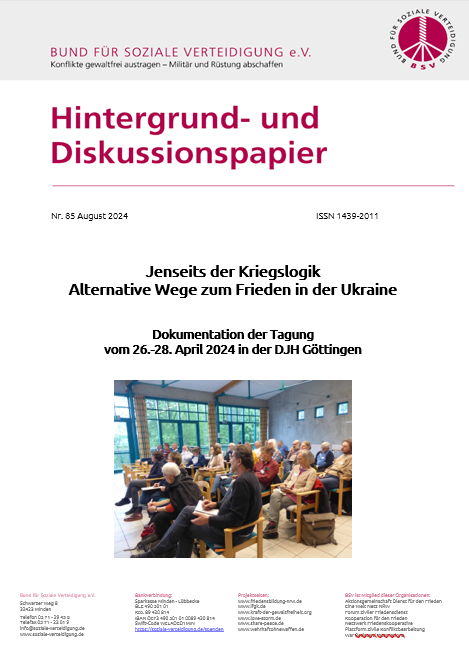
3,50 €
Hintergrund- und Diskussionspapier Nr. 85:
Jenseits der Kriegslogik. Alternative Wege zum Frieden in der Ukraine. Dokumentation der Tagung vom 26.-28. April 2024 in der DJH Göttingen
Hrsg. Bund für Soziale Verteidigung, August 2024, 34 Seiten, ISSN 1439-2011, 3.50 Euro
Dieses Hintergrund- und Diskussionspapier enthält Vorträge und Zusammenfassungen der Vorträge und Diskussionen der gleichnamigen Tagung, die der Bund für Soziale Verteidigung Ende April 2024 veranstaltet hat.
Es ging um folgende Fragen: Welche friedenslogischen und friedensorientierten Ansätze gibt es, diesen Konflikt, der ja weit über die unmittelbar an den Kämpfen beteiligten Länder hinaus geht, zu bearbeiten? Was können wir aus der Beendigung anderer Kriege lernen? Hat uns die – doch oftmals doch sehr andere – Sicht auf den Krieg aus den Ländern des Globalen Südens was zu sagen? Die Sicht aus den Zivilgesellschaften der betroffenen Länder? Und was wird passieren, wenn die Waffen eines Tages wieder schweigen?
Inhaltsverzeichnis
– Einleitung (Dr. Christine Schweitzer)
– Wege aus Kriegen in Geschichte und Gegenwart (Dr. Gbeognin Mickael Houngbedji)
– Sicht auf den Krieg aus dem Globalem Süden (Zusammenfassung Vortrag Dr. Boniface Mabanza Bambu)
– Sicht aus der ukrainischen Zivilgesellschaft (Bernhard Clasen)
– Wie verhindern, dass der Krieg eskaliert? Eskalationsgefahren und Verhandlungsvorschläge (Clemens Ronnefeldt)
– Widerstand in den von Krieg betroffenen Ländern (Zusammenfassung der AG)
– Nach dem Krieg: Wie die Folgen des Kriegs in den beteiligten Ländern bearbeiten? (Duška Borovac-Knabe)
– Wie den neuen Kalten Krieg in seinen Anfängen stoppen? (Zusammenfassung der AG)
– Konkrete Ansätze aus der Friedensbewegung / von uns. Was nehmen wir mit, was können wir tun? (Abschluss am Sonntagmorgen)
– Anhang 1: Resolution der Tagung „Jenseits der Kriegslogik – Alternative Wege zum Frieden in der Ukraine”
– Anhang 2: Asyl oder humanitäre Visa für russische Kriegsdienstverweigerer, Deserteure oder Militärdienstentzieher!
Bund für Soziale Verteidigung e.V.
Wir glauben, dass das Internet für jeden zugänglich sein sollte. Deshalb bemühen wir uns, unsere Webseite so barrierefrei wie möglich zu machen, damit alle Menschen sie nutzen können, egal welche Fähigkeiten oder Einschränkungen sie haben.
Wir halten uns an die Richtlinien des W3C (World Wide Web Consortium) für barrierefreies Webdesign, die erklären, wie Webseiten für Menschen mit Behinderungen zugänglich gemacht werden können. Das hilft uns, die Webseite für blinde Menschen, Menschen mit motorischen Einschränkungen, Sehbehinderungen, kognitiven Beeinträchtigungen und andere zugänglich zu machen.
Unsere Webseite nutzt spezielle Technologien, um die Zugänglichkeit zu verbessern. Es gibt eine Bedienoberfläche, die es Menschen mit bestimmten Einschränkungen erlaubt, die Webseite an ihre Bedürfnisse anzupassen.
Außerdem verwenden wir eine KI-gestützte Anwendung im Hintergrund, die ständig die Zugänglichkeit der Webseite verbessert. Sie passt den Code an, damit Bildschirmleser (für blinde Nutzer) besser funktionieren, und sorgt dafür, dass die Webseite auch mit Tastatur gut bedienbar ist.
Wenn du einen Fehler findest oder Vorschläge hast, freuen wir uns, von dir zu hören. Du kannst uns eine E-Mail schicken:info@soziale-verteidigung.de
Unsere Webseite ist so gestaltet, dass auch blinde Nutzer sie gut nutzen können. Es gibt spezielle Hinweise und Einstellungen, die den Bildschirmlesern helfen, die Inhalte richtig vorzulesen. Wenn jemand die Webseite mit einem Bildschirmleser betritt, wird er gefragt, ob er den „Screen-Reader-Modus“ aktivieren möchte.
Die Webseite erkennt die wichtigsten Anforderungen für Bildschirmleser und passt sich an. Sie beschreibt Bilder mit Texten (ALT-Texte), gibt Hinweise zu Formularen und Buttons und liest auch Texte innerhalb von Bildern vor (mit spezieller Technik). Mit Tastaturkürzeln kann man schnell zu bestimmten Bereichen springen, z.B. zu Menüs, Überschriften oder Formularen.
Benutzer können Schriftgröße, Farben, Kontraste und Animationen ändern, um die Webseite an ihre Bedürfnisse anzupassen. Es gibt auch Funktionen wie das Stummschalten von Ton, Hervorheben wichtiger Inhalte, Ändern des Cursor-Designs und mehr.
Wir unterstützen die wichtigsten Browser (wie Chrome, Firefox, Safari, Edge) und Bildschirmleser (wie JAWS, NVDA), damit möglichst viele Menschen unsere Webseite nutzen können.
Trotz aller Bemühungen kann es sein, dass manche Seiten noch nicht vollständig barrierefrei sind. Wir arbeiten ständig daran, die Zugänglichkeit zu verbessern. Wenn du Hilfe brauchst oder Vorschläge hast, kannst du uns gerne kontaktieren. info@soziale-verteidigung.de